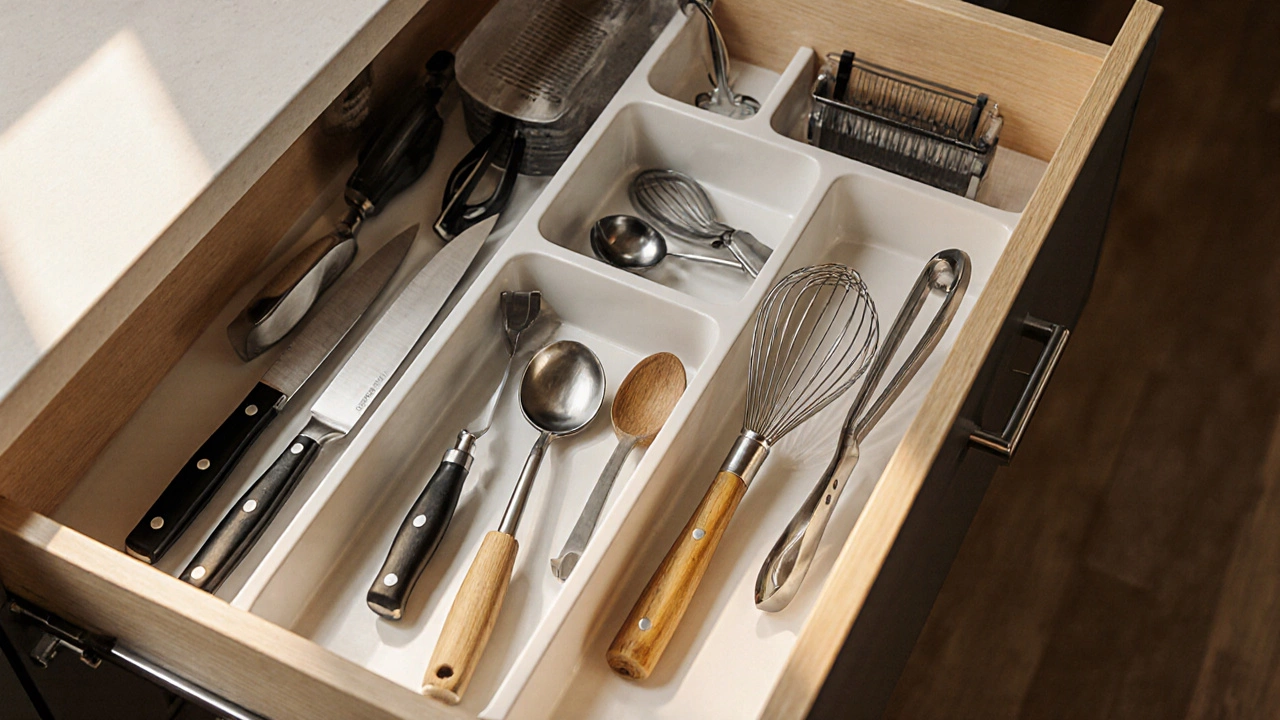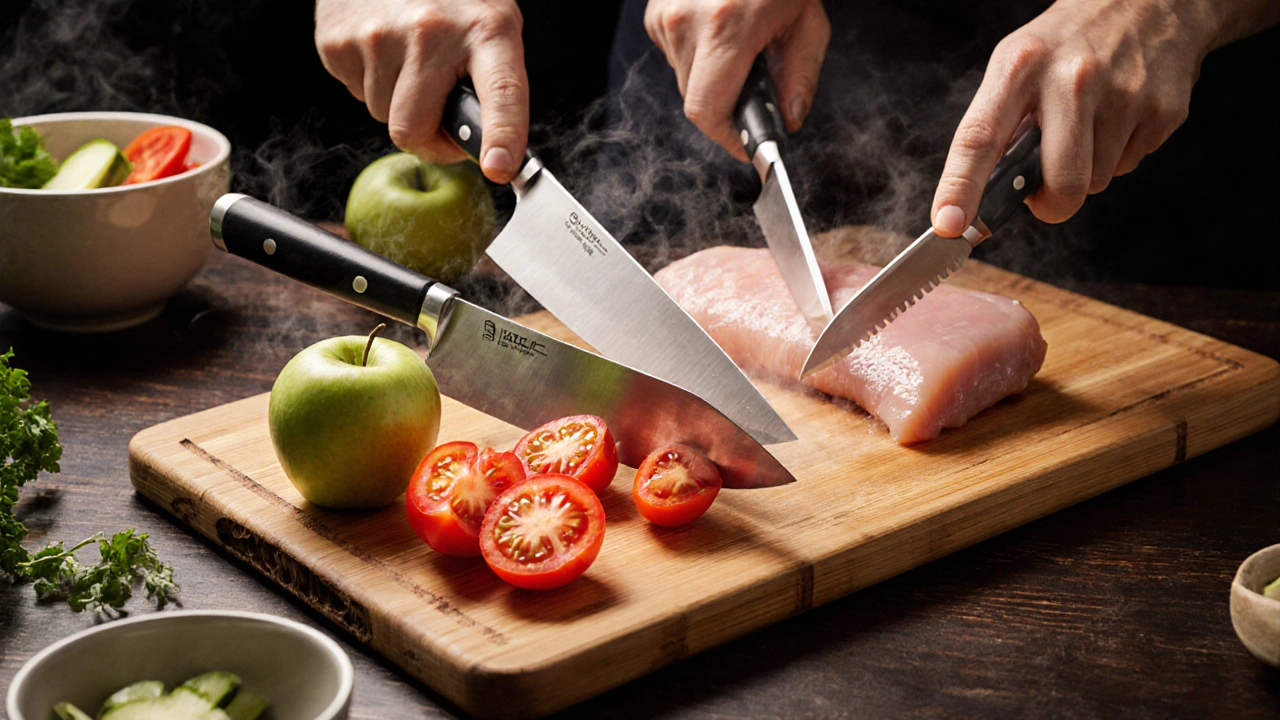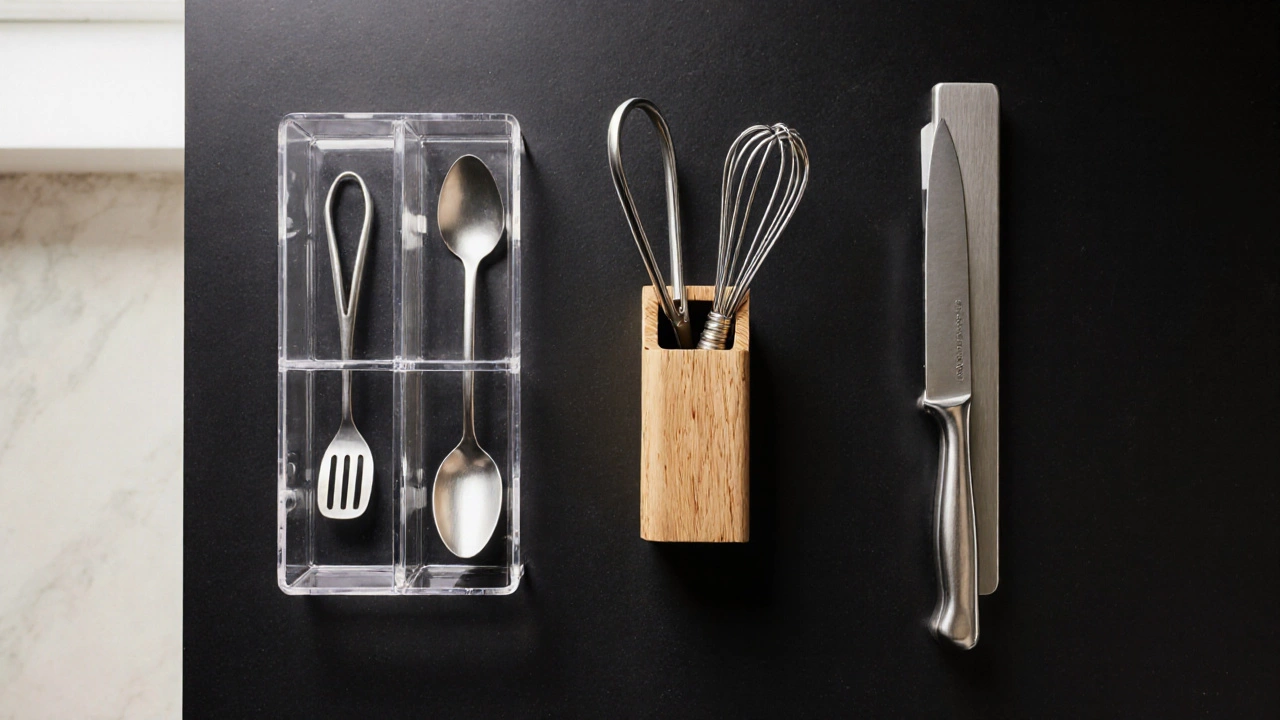5 Main Categories of Kitchen Utensils Explained

Kitchen Utensil Assessment Tool
Assess Your Kitchen Utensil Collection
Select which utensils you have in each category to see what you're missing for a balanced kitchen setup.
Cutting Tools
Cooking Tools
Mixing Tools
Serving Tools
Storage Accessories
Your Collection Assessment
Ever stood in front of a drawer full of gadgets and wondered why they’re grouped the way they are? Understanding the five main categories of kitchen utensils helps you stock smarter, clean faster, and actually enjoy cooking.
Key Takeaways
- Utensils split into Cutting, Cooking, Mixing, Serving, and Storage groups.
- Each category serves a unique function and often shares material preferences.
- Choosing the right tool for the task saves time, reduces wear, and improves food quality.
- Investing in a few high‑quality pieces per group beats a clutter of cheap, single‑use items.
- Regular maintenance-cleaning, sharpening, and replacing worn parts-keeps every category performing at its best.
Kitchen utensils are the handheld tools you use to prep, cook, serve, and store food. They range from a simple wooden spoon to a high‑tech silicone spatula, but they all fall into five broad groups that make sense in a kitchen workflow.
1. Cutting Tools
Cutting tools are the weapons of the prep station. Their job is to transform whole ingredients into bite‑size pieces, strips, or ribbons. The core of this group is the chef’s knife, usually 8‑10inches long, forged from high‑carbon stainless steel and featuring a comfortable bolster. Alongside the chef’s knife you’ll find paring knives, boning knives, and utility knives, each with a specific blade shape and length for niche tasks.
- Chef’s knife - versatile, all‑purpose, best for chopping, slicing, and dicing.
- Paring knife - short, pointed, ideal for peeling and intricate work.
- Boning knife - narrow, flexible, perfect for removing meat from bone.
Materials matter: high‑carbon stainless steel holds an edge longer, while ceramic blades stay sharp but chip under stress. A sturdy cutting board-wood or bamboo-protects both blade and countertop.
2. Cooking Tools
Cooking tools are the implements that move food through heat. They must withstand high temperatures and provide enough control to flip, lift, or stir without breaking.
- Spatula - flat, flexible, great for flipping pancakes or scraping pans.
- Ladle - deep, often stainless steel or heat‑resistant plastic, used for soups and sauces.
- Tongs - lock‑jaw design, ideal for turning meat or serving salad.
- Whisk - balloon‑shaped, used for beating eggs, emulsifying dressings, or incorporating air into batter.
Silicone grips on spatulas and tongs prevent scratching non‑stick surfaces, while stainless steel handles survive oven heat. A good whisk balances flexibility and stiffness; balloon whisks incorporate the most air, while flat whisks excel at making roux.

3. Mixing Tools
Mixing tools bring ingredients together uniformly. They differ from cooking tools in that they’re usually used before heat is applied.
- Handheld beaters - metal or silicone wires, perfect for light batters.
- Wooden spoons - sturdy, heat‑tolerant, ideal for stirring custards.
- Silicone mixing spatulas - flexible, good for folding batter without deflating.
When you need power, a stand‑mixers’ paddle attachment becomes a hybrid mixing‑cooking tool, but for most home cooks a set of sturdy spoons and a good whisk does the trick.
4. Serving Tools
Serving tools bridge the kitchen and the table. They’re chosen for aesthetics as well as function.
- Serving spoons - larger than regular spoons, often with a flatter bowl for scooping gravies.
- Salad servers - a pair of large, slightly curved tongs that make tossing easy.
- Pie servers - slotted, wide‑spatula style, perfect for lifting slices without breaking crust.
Materials shift toward polished stainless steel or brushed gold for visual appeal, while silicone and wood remain popular for a warm, rustic look.
5. Storage Accessories
Storage accessories keep your tools organized, safe, and ready for the next cooking session.
- Drawer dividers - adjustable acrylic or bamboo trays that separate knives, spatulas, and whisks.
- Utensil crock - countertop holder that keeps frequently used tools within arm’s reach.
- Magnetic knife strip - wall‑mounted steel strip that stores knives edge‑up, preserving blade integrity.
Choosing the right storage solution reduces clutter, protects delicate handles, and extends the life of each utensil.

Comparison of the Five Categories
| Category | Typical Items | Primary Material | Core Function |
|---|---|---|---|
| Cutting Tools | Chef’s knife, Paring knife, Boning knife | High‑carbon stainless steel | Prep & portion |
| Cooking Tools | Spatula, Ladle, Tongs, Whisk | Stainless steel, Silicone | Move food through heat |
| Mixing Tools | Whisk, Wooden spoon, Silicone spatula | Silicone, Wood, Metal | Combine ingredients |
| Serving Tools | Serving spoon, Salad servers, Pie server | Stainless steel, Wood, Silicone | Present food |
| Storage Accessories | Drawer dividers, Utensil crock, Magnetic strip | Acrylic, Bamboo, Steel | Organise & protect |
Practical Checklist for a Balanced Utensil Set
- ✓ One high‑quality chef’s knife (cutting)
- ✓ A sturdy spatula and a pair of tongs (cooking)
- ✓ A whisk and a wooden spoon (mixing)
- ✓ A serving spoon and salad servers (serving)
- ✓ Drawer dividers or a magnetic strip (storage)
Stick to this list and you’ll cover 95% of home‑cooking scenarios without over‑buying.
Frequently Asked Questions
Do I really need a separate boning knife?
If you often work with whole cuts of meat, a boning knife saves time and yields cleaner cuts. For casual cooks, a flexible fillet knife can double as a boning tool.
Can silicone spatulas scratch non‑stick pans?
No. Silicone is one of the safest materials for non‑stick surfaces. Just avoid metal‑tipped varieties.
How often should I sharpen my chef’s knife?
A professional edge lasts about 6‑8 weeks with regular home use. Hone it weekly with a ceramic rod and send it for a full sharpen a couple of times a year.
Is a wooden spoon good for high‑heat cooking?
Yes, solid wood tolerates high heat and won’t melt. Just keep an eye on it to prevent charring.
What’s the best way to store knives safely?
A magnetic knife strip keeps blades protected and out of the drawer, while a wooden block offers a traditional, sturdy option.